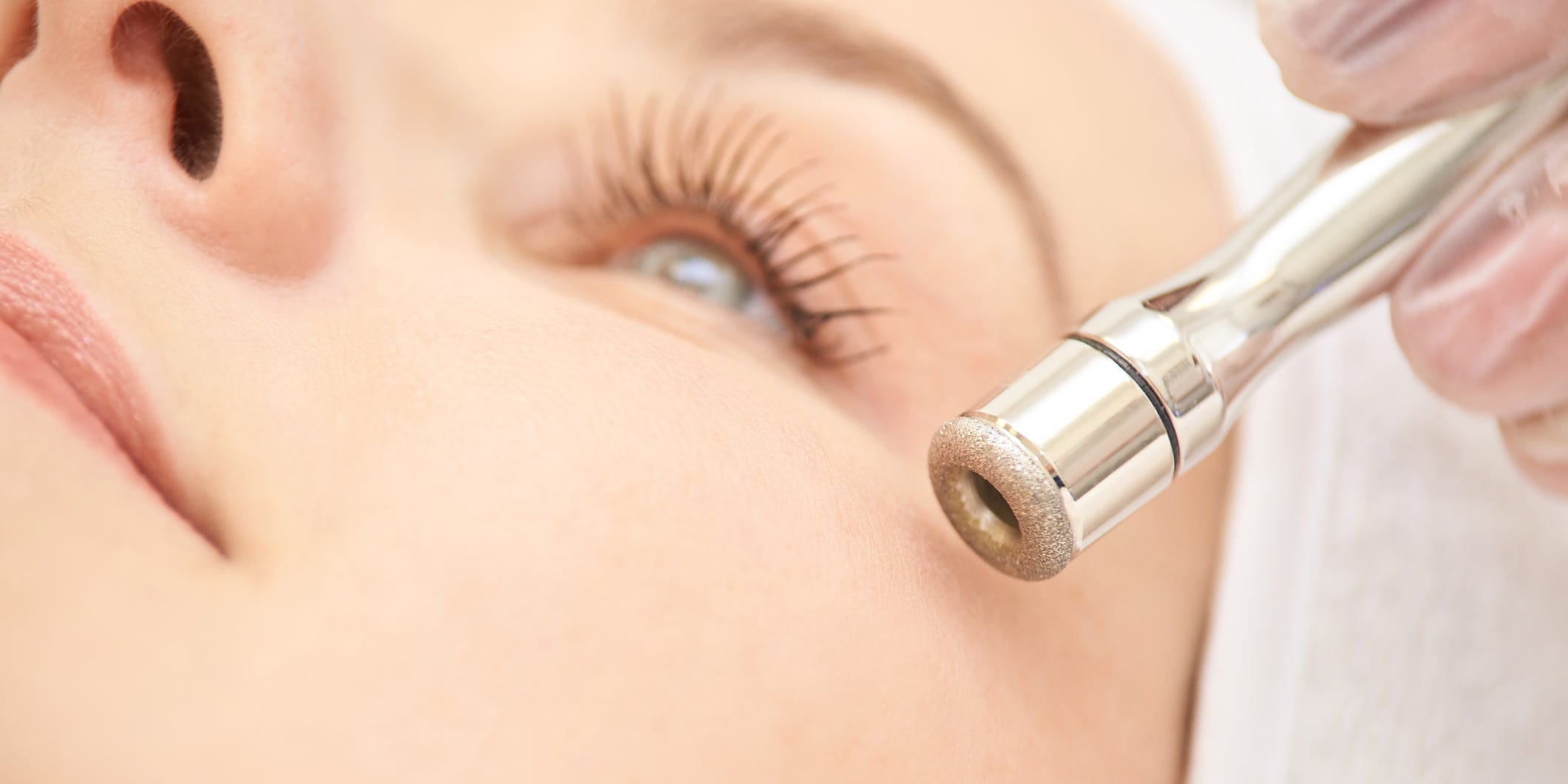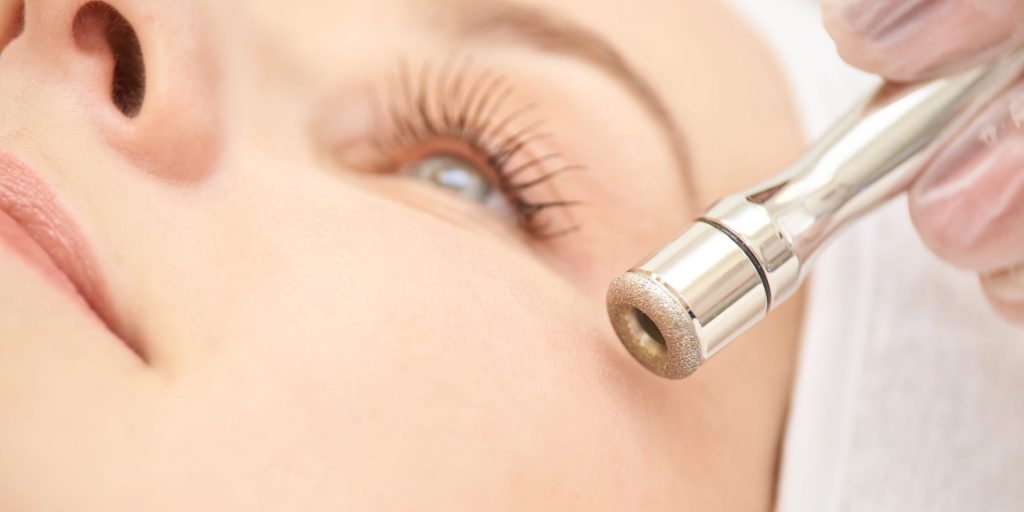
Elena Volf/Getty Images
- Dermabrasion is a procedure that exfoliates your skin by sanding off the outer layer of skin cells.
- It may help treat sun damage, scarring, hyperpigmentation, stretch marks, and wrinkles.
- The procedure comes with risks, including a painful recovery, infection, and bumpy skin.
- Visit Insider's Health Reference library for more advice.
Dermabrasion is a procedure that deeply exfoliates your skin using a sanding tool. It can treat skin conditions on your face including acne, scarring, sun damage, and wrinkles.
But the procedure has become less popular in recent years, likely because the recovery can be painful and it takes months for your skin to heal completely.
"For minor cosmetic touch ups, you may want to explore a less-intense procedure like microdermabrasion, facial peels, or laser treatments," says Dendy Engelman, MD, a board certified cosmetic dermatologist at the Shafer Clinic, NYC.
Here's what a dermabrasion procedure is like and how it can help your skin.
What is dermabrasion?
During a dermabrasion treatment, a dermatologist or plastic surgeon will use a dermabrader to sand off the outer layers of your skin. This can help repair damaged or scarred skin by ramping up the production of new skin cells in the treated area, says Engelman.
When your skin cells turn over, dead skin is shed and younger skin comes to the surface. This results in brighter skin, smaller-looking pores, and can even reduce the appearance of dryness.
Dermabrasion is different from microdermabrasion - a procedure that uses a less abrasive tool and removes fewer layers of skin. Dermabrasion is more effective to remove deeper skin imperfections like deep scars, but microdermabrasion has an easier recovery.
On average, a microdermabrasion procedure costs about $170, while dermabrasion costs around $1800. There are also at-home microdermabrasion kits you can try.
The dermabrasion procedure: Before, during, and after
A dermabrasion procedure must be performed by a skincare professional. You can't do dermabrasion at home because the procedure requires surgical tools and carries risks like infection and scarring if done incorrectly.
Before the procedure
To prepare for a dermabrasion procedure, you'll need to take steps to make sure you get the best results possible:
A few weeks before the procedure:
- Stop smoking. You should stop smoking for a week or two before the procedure. Smoking can limit the blood flow in your skin and slow down healing.
A few days before the procedure:
- Take antiviral medications. Your doctor may prescribe you an antiviral medication to help prevent infection.
- Get Botox injections. Your doctor may recommend that you get Botox about three days before the procedure to help prevent wrinkles during the healing process.
Ask your doctor:
- Stop some medications. You may need to stop taking blood-thinning medications like aspirin before having dermabrasion. Ask your doctor how long you should start discontinuing your drugs before the procedure.
- Avoid sun exposure. Getting too much sun before dermabrasion can cause permanent spots of discoloration in your skin. Your doctor can advise how long you should take these precautions.
During the procedure
Because it's relatively low-risk, dermabrasion is usually done in your doctor's office rather than a hospital. Here's how it usually goes:
- Your doctor generally gives you local anesthesia to numb your skin or put you under sedation for longer, more extensive procedures.
- Your skin will be cleansed with an antiseptic gel.
- Your doctor will move the dermabrader across your skin, removing the outermost layers of the epidermis and dead skin cells. Depending on how much skin you're treating, this may take just a few minutes or more than an hour. For example, a small scar removal might be a quicker procedure, while a full face procedure may take longer.
- After the dermabrasion, your doctor will cover the treated area with a moist bandage to prevent your skin from crusting and delaying healing. You should keep the bandage on all day and your doctor will change the dressing in-office the following day, Engelman says.
- You can go home right after the procedure, but you will need someone else to drive if you were sedated.
After the procedure
- You should notice some improvement within a week or two, but it takes about three months for your skin to heal completely, Engelman says.
- During the healing process, you may have normal symptoms like:
- Red and swollen skin
- A burning or aching feeling
- Itching as new skin grows
- Scabs or crust forming over treated areas
- To treat any pain, your doctor may recommend an over-the-counter pain reliever or offer a prescription pain medication.
- Don't use any makeup to cover redness until a new layer of skin has fully grown in. New skin generally grows back in five to eight days and should look pink in appearance.
The benefits and risks of dermabrasion
Dermabrasion might help reduce the appearance of some skin conditions, but it also comes with risks.
Benefits of dermabrasion
- Scar reduction. Studies show that dermabrasion works well to reduce the appearance of scars from acne and facial surgery.
- Post-burn treatment. A 2007 study found that dermabrasion can help treat skin discoloration in people who have experienced burns.
- Reduce sun damage. A small study from 2008 found that dermabrasion, along with surgery, helped improve skin discoloration in people with severe sun damage on their lips.
- Reduce stretch marks. A 2019 study found that getting 10 dermabrasion treatments made stretch marks appear shorter and thinner for women with stretch marks on their backsides.
The results of dermabrasion are permanent, but you often need three to six treatments to get full results. If the treatment is meant to combat aging, you may need to have follow-up treatments to maintain your results.
Risks of dermabrasion
- Bumpy skin. Treated skin may develop tiny white bumps, but these often go away on their own with regular face washing.
- Infection. In rare cases, you can develop a bacterial, viral, or fungal infection on your skin.
- Scarring. If dermabrasion is done too deeply, you can develop scarring.
- Larger pores. Your pores may appear larger after getting dermabrasion treatment.
- Skin discoloration. In rare cases, your skin can become permanently lighter or darker after treatment. People with darker skin tones are at greater risk.
Insider's takeaway
Dermabrasion can be a great way to "reset" your skin by removing damaged skin, evening out your skin tone, and reducing scars. It can also be a non-invasive way to remove small but potentially dangerous precancerous spots.
"However, dermabrasion does have downtime and side effects like sensitivity and redness," Engelman says. Following your doctor's instructions carefully can help avoid complications and give you the best results possible.
